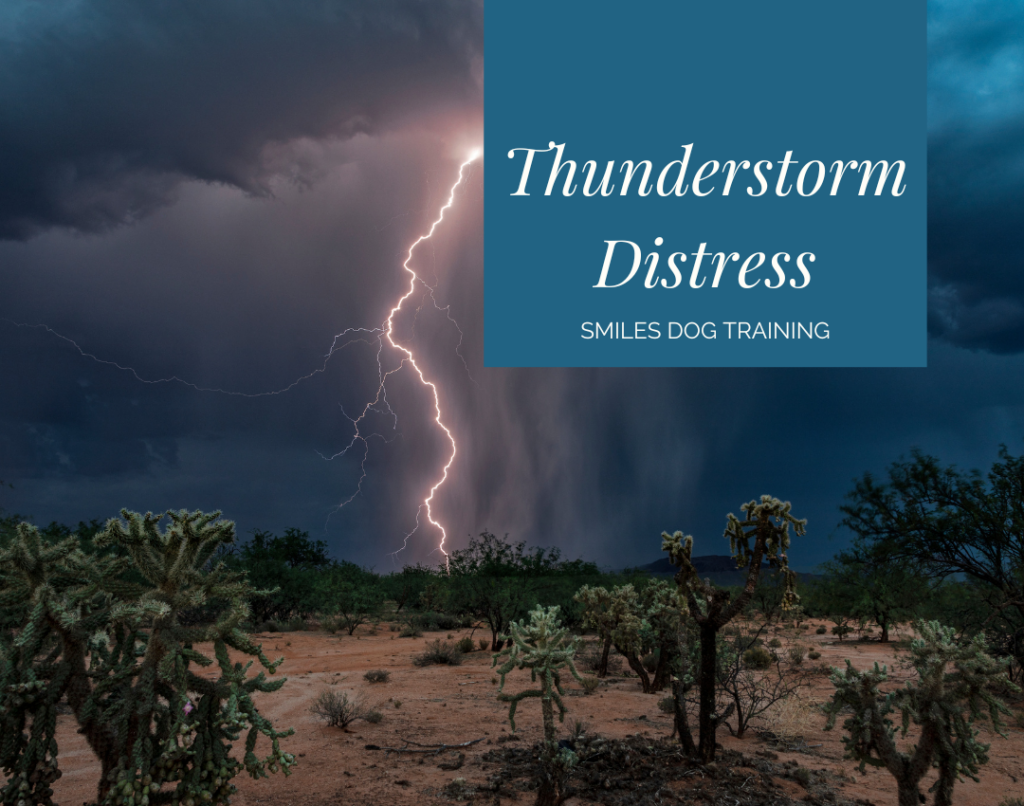The monsoons have arrived! While some may find comfort in the cozy ambience of a thunderstorm, many dogs experience an entirely different reaction – fear and anxiety.
If your pup trembles, hides, or seeks solace during storms, you are not alone. Thunderstorm distress is a prevalent issue among dogs, affecting all breeds and backgrounds. In this blog post, we will explore gentle techniques and proven strategies to weather the storm together.
Unraveling Thunderstorm Distress
Thunderstorm distress in dogs manifests through a range of telltale signs, often leaving pet owners concerned and eager to help.
Some dogs may become excessively clingy, seeking constant reassurance and comfort during storms, while others display opposite behavior, attempting to escape or hide from the frightening sounds and flashes. Pacing, whining, trembling, excessive drooling, and destructive behavior are also common indicators of their distress.
The fear response in dogs during thunderstorms can be triggered by a combination of factors. The loud claps of thunder, sudden flashes of lightning, changes in barometric pressure, and even the static electricity in the air can all contribute to their unease.
Additionally, past negative experiences with thunderstorms, such as getting caught in heavy rains or hearing loud noises during storms, can further heighten their fear.
The impact of this distress on a dog’s behavior and well-being can be significant, leading to decreased appetite, disrupted sleep patterns, and even avoidance of previously enjoyed activities.
In severe cases, prolonged anxiety can lead to more serious health issues, negatively affecting their overall quality of life.
Understanding these signs, triggers, and effects of thunderstorm distress is the first step toward helping our beloved companions find comfort and security during these unsettling weather events.
Preparing for Stormy Nights
Designing a comforting environment for your pup is a crucial step in alleviating their thunderstorm distress. Start by identifying a quiet, enclosed space in your home where your dog feels secure, such as a cozy corner or a dedicated room. Some of my client dogs have preferred a bathtub, laundry basket, or open closet for their safe space.
Ensure that this area is well-insulated to muffle the sound of thunder and rain. Adding soft bedding, like a plush bed or a pile of blankets, can create a sense of comfort and security. Introduce familiar scents, such as their favorite toys or a piece of your clothing, to further reassure them in their designated space. We also love adding Adaptil to the space to increase your pup’s overall feeling of safety. (Check it out in our online shop!)
Closing the curtains or blinds can help block out the visual disturbances caused by lightning flashes. Playing soothing background music or white noise (box fans are great for this!) can help drown out the sounds of the storm.
By designing a calming environment tailored to your dog’s needs, you provide them with a reassuring retreat where they can seek solace and feel protected during the unsettling moments of thunderstorms.
Food Puzzles and Interactive Toys
Exploring the use of interactive toys and puzzles can be an excellent way to distract and relax anxious dogs during thunderstorms or other fear-inducing situations. These mentally stimulating activities engage their focus, redirecting their attention away from the distressing stimuli outside. Interactive toys, such as treat-dispensing puzzles or toys that require problem-solving, can help keep their minds occupied and promote a sense of accomplishment when they successfully complete the task.
Need some toy suggestions? Check out our Amazon shop for our favorites!
However, it is essential to approach this mindfully. While these toys offer temporary relief they are also only a band-aid solution. Continuing to build your dog’s confidence by implementing positive reinforcement training techniques remains priority. This ensures that interactive toys and puzzles don’t become a predictor of bad things!
Using Kind and Safe Behavior Change Techniques for Storm Fear
Using positive reinforcement techniques for fear-based behavior is of utmost importance because it fosters trust, builds confidence, and encourages a positive emotional association with challenging situations.
Unlike punitive methods, which may exacerbate fear and anxiety, positive reinforcement focuses on rewarding desired behaviors which empowers the dog to face their fears gradually. Moreover, it helps to reshape the dog’s emotional response to fear-inducing stimuli, transforming their perception from one of apprehension to one of confidence and resilience.
Counter-conditioning is a powerful technique used to change a dog’s emotional response to thunderstorms and other triggers. During calm periods when no storms are happening, you can begin the process by creating positive associations with storm-related cues. For instance, you might play soft recordings of thunder at a barely audible volume while engaging your dog in enjoyable activities or providing their favorite treats. This helps them associate the sound with positive experiences instead of fear.
During actual storms, reinforcing calm behavior and coping mechanisms becomes crucial. Reward your dog whenever they display signs of relaxation or engage in activities that distract them from the storm’s effects. By doing so, you reinforce the idea that staying calm during storms brings good things.
Gradually, through shaping, you can build your dog’s tolerance to storm-related triggers. This involves exposing them to slightly more intense storm sounds or visual cues over time, rewarding them for their improved coping abilities at each step.
Seeking Professional Help
Recognizing when to consult a professional canine behavior specialist is essential, especially when dealing with severe cases of thunderstorm anxiety in dogs. While plenty of pet parents can make significant progress with their dogs using positive reinforcement techniques, many more situations require specialized expertise and experience.
If your dog’s fear of thunderstorms persists despite your best efforts or if their anxiety significantly affects their overall well-being, seeking professional guidance becomes crucial. A qualified canine behavior specialist can assess your dog’s specific needs, design a custom training plan, and provide valuable insights into addressing their distress effectively.
Qualified professionals also have experience handling various behavioral issues, enabling them to identify potential underlying factors contributing to your dog’s fear. Your behavior specialist may also recognize that your situation requires additional help from your veterinarian or a veterinary behaviorist for physical health and/or behavioral medication support. Working together as a team ensures consistent implementation of the training plan, reinforces positive behaviors, and fosters a supportive environment for the dog to be successful.
By understanding the signs, triggers, and impacts of fear-based behavior during storms, we can create a comforting environment that offers solace and security. Embracing the power of positive reinforcement enables us to empower our dogs, helping them conquer their thunderstorm distress and face new challenges with courage and joy.



